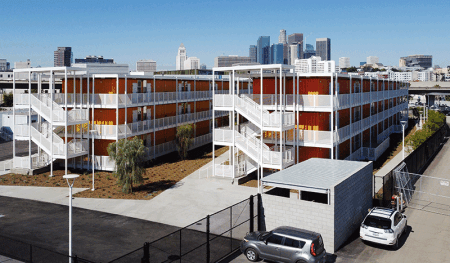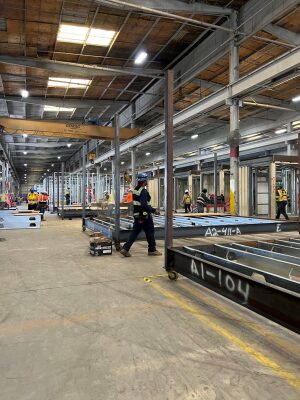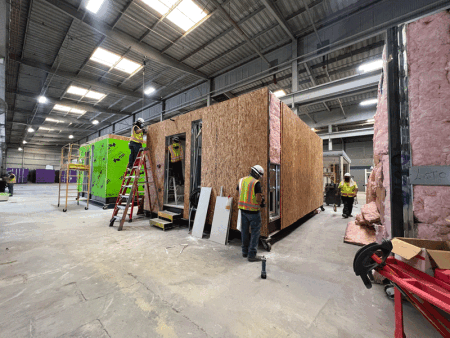The Hilda L. Solis Care First Village, a roughly $48 million, 232-unit project in downtown Los Angeles, was erected in a matter of months. Built with CRATE Modular components, it is one of a growing number of modular construction projects that will help address the housing affordability crisis, streamlining the construction process, saving time, and reducing the need for labor.
Jaren Grady, director of business development at the Carson, California–based manufacturer, says, “The goal for any developer is return on investment and so, the sooner you complete a building product, the sooner it can be occupied and it can start collecting revenue or rents the better.” The city got an almost immediate return on investment on this project, which was a six-month turnaround from idea to occupancy, “but more importantly, it helped many formerly homeless people get off the streets and receive the help they deserve,” Grady says.
The project, built next to the Men’s Central Jail, is part of an effort to offer more housing in a city that has 69,144 unhoused individuals, according to the Los Angeles Homeless Services Authority.
Grady says modular construction is an ideal way to build any project because it offers a repeatable and scalable approach. “With modular or factory-built housing, we are able to compress the construction schedule by doing concurrent activities,” he explains. “In other words, at the same time, the site is being developed—i.e. site grading, sewer, and utility connections for water, power, and gas. The building modules are being built in an environmentally (controlled), clean, and orderly factory setting. Most of the time the building modules are completed and ready for delivery before the site is completed.”
The cost savings for modular projects are also significant. When the Solis Care First Village project was built four years ago, for example, the average cost per unit was around $245,000 compared to the average cost then of around $535,000 per unit in California, according to Grady.
Margaret Whelan, founder and CEO of New York-based Whelan Advisory Capital Markets and a board member of the Housing Innovation Alliance, says, “Factory settings allow for a lot more reliable external factors, from who is doing the work, to the floor plans being used and the materials being installed. This reduces rework, waste, theft, and errors, most of which get passed along to the consumer in the form of higher pricing.”
Given the skilled-labor shortage in the construction industry, proponents of modular building say it can offer solutions. This is especially true given the fact most construction workers are middle aged and nearing retirement. The modular industry, because of the way it is set up, can help attract not only more workers, in general, but a more diverse workforce, according to Grady.
“We enjoy a great labor retention rate compared to traditional construction,” Grady says. “Part of the reason is that we can promise a potential CRATE Modular laborer that they can establish roots in the same community where they work, because the job site is constant, all our work is done in or at the factory in Carson, California. As opposed to a traditional construction laborer who may be traveling/working to a job site in Hemet for one month and the next month be working on a job site in Lancaster, it is really living the life of a nomad with a poor work-life balance.”
Planning for the Future
Modular construction accounted for approximately 6 percent of new construction last year in North America, according to the trade organization Modular Building Institute. It is not only private industry that is touting the merits of modular housing. The federal government has recently begun supporting it as well.
The Biden administration last year introduced the possibility of offering financing plans for modular construction to boost the housing supply as part of a Housing Supply Action Plan. As part of the program, Biden’s budget for this year proposed that $25 billion be set aside for Grants for Affordable Housing Production, which would include new modular projects. It is part of an effort to develop approximately 500,000 multifamily units over the next decade.
Despite this, Dennis Steigerwalt, president of Pittsburgh-based Housing Innovation Alliance, maintains that modular housing has so far been progressing at a snail’s pace. “There’s nowhere but up to go from a growth opportunity perspective,” he says.
Jeffrey Lubell, a leading authority on housing and community development at the Rockville, Maryland-based research and consulting firm Abt Associates, argues that the benefit of building offsite can aid in increasing flexibility, which allows for a broader range of housing offerings, producing less waste and using material more efficiently.
“Off-site construction, which includes modular and manufactured housing, has a number of important advantages over stick-built housing,” Lubell says. “One of the most important of these advantages is the ability to achieve economies of scale that allow for the production of large volumes of housing at a lower cost that can be achieved when individual homes are built one at a time in disparate locations.”
Darren Seary, principal at Mission Viejo, California-based Optimum Modular Solutions, agrees modular building has major advantages. He says he was first introduced to modular construction several years ago as part of a four-story hotel project in the San Francisco Bay Area for which he was providing risk management services for construction lenders at the time while working for another company. He also toured a modular factory as part of the process.
“On my first modular project, I buried myself in the project to really understand all aspects of the total project from design through completion and identify the pros and cons of something fairly new to me at the time,” Seary says. I found at the time that it required less labor, and we were seeing labor being a major issue in terms of availability and associated pricing. I didn’t anticipate that getting any better, and it hasn’t. It’s gotten worse over the past decade. By reducing labor, manufacturing the modules while sitework and foundations are being completed on site, and having the ability to build the majority of the buildings without having weather delays, significant schedule savings should be achieved on modular projects.
Wood is often used in modular construction as well as steel. More architectural firms have also been incorporating modular into their design offerings. The best design approach is standardization, according to Grady.
“When you build with modular process, during the early design phases you’re always trying to follow good Design For Manufacturing & Assembly (DFMA) principles; always focusing on reducing time-to-market and total production costs by prioritizing both the ease of manufacture for the product’s parts and the simplified assembly of those parts into the final product,” Grady says. “The automobile industry is a good example of how we build our building products. The building components or parts designed are constantly being perfected in how they go together, and so you can be built more efficiently and faster.”
Ease of Permitting
There are also other advantages when it comes to securing permits, Seary says.
“The permitting period is typically less because the city or county, the local AHJ, has less to review because the modules are being reviewed by the state typically,” Seary says. “There can be simultaneous plan review processes, and the state process is typically quicker, and then you typically are breaking ground much sooner.”
However, dealing with policies and codes in different cities can often prove to be challenging. Steigerwalt says this is due to the fact there is currently not a uniform policy to follow.
“There are some jurisdictions that are much more familiar with it than others,” Steigerwalt says. The City of Pittsburgh, for example, has created an expedited process for approving modular construction thought it can vary state by state. However, modular construction must meet the same state and local building codes for whichever local jurisdiction the project is being built, experts say.
Designing with Ease
Experts say modular construction is ideal for a variety of projects, including multifamily as well as schools, hotels, and college dormitories. “The sweet spot for modular I would say is any building type that is stackable and repeatable,” Grady says.
Another attraction is that there is a control element that comes with modular projects where the design process is concerned. Projects are often built digitally.
“We build a digital, twin model of the building product in the computer—down to how many screws and bolts we’re using,” Grady says. “By creating a very accurate and detailed Billing of Materials (BOM) thru BIM, so we know exactly which material and how much materials will be required. More importantly, we know exactly how much materials will cost. It’s all done in a computer using the latest technology, building this way helps to minimize or (in) some cases eliminate change orders.”
The same floorplans and modules are, generally, repeated throughout projects, according to Seary.
Quality control goes hand in hand with the manufacturing process, Steigerwalt explains. “You get to see everything before it runs down the line, and the line is only running if you have everything you need,” he says.
For modular construction to work most effectively, there are some things builders and clients need to keep top of mind. Experts say to be successful, it is vital to be educated about the process and best practices, including about the fact that a lot of the decision making is done ahead of time, which requires decisiveness.
“I always warn my clients that modular construction relies on a lot of decision-making up front,” Seary says. “So you have to be decisive because with these modules, it’s like a car manufacturing plant. You wouldn’t turn around to Ford as they start production and say, ‘Oh, by the way, I want to change the steering wheels. Once it starts on the production line, that’s essentially it.”
More ULI Resources:








